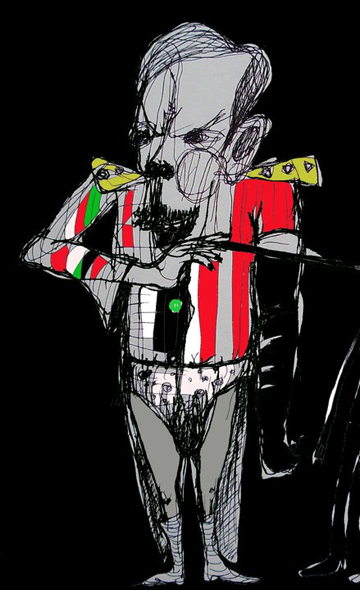By Elie Chalala
In analyzing all of the discourse about the Arab Spring and the Syrian revolution, the claim that seems to be most central is the breaking-down of the wall of fear. The evidence supporting this claim is overwhelming: the death of 80,000 Syrians, the disappearance and imprisonment of tens of thousands, the targeting of civilians by military aircraft, Scud missiles, cluster, phosphoric, and barrel bombs, to the displacement of close to four million people inside and outside of Syria. Of equal if not greater significance is the continued resistance against the Assad dictatorship, now two years old, and a historic event unprecedented in modern Arab history. Yet, there has not been a sizable literature, much less books in English on this subject that stand out. Thus any evidence that might enrich such literature is worthy of collection, and the interview Dima Wannous conducted with the young Syrian artist, Mohammed Amran, modest as it is, shed some light on how politically conscious Syrians saw and perceived fear under the Assads' dictatorship.
Mohammad Amran stood with the Syrian revolution from the very beginning, utilizing his creative work as a means of support, wrote Dima Wannous in the cultural section of the Lebanon-based Mudon electronic newspaper. "He has not hesitated for a moment, as if he had been preparing for the Syrian revolution from childhood."
His harsh indictment of dictatorship in Syria aside, he does not refrain from criticizing some of the practices of the rebels, telling Wannous that "these practices started to provoke me, and we have to start to be critical."
But he was critical from the days of his youth, when he was enlisted in what then called "Baath Vanguards."' As he told Wannous, he was neither a "vanguard" nor a "Baathist."
"I used to fear Hafez al-Assad in my childhood, fearing the frame of his body, and his features which used to frighten me most. I used to see him as someone above the earth, as god, his frowned eyes were quite frightening, while his voice cannot be described. That voice comes out choked, and thin as that of an old man. His pictures were plastered on our school notebooks...Fear has a picture... and the picture is connected with him personally," Amran told Wannous.
In the end of her meeting with Amran, he told Wannous one of the many stories of continued fear which he lived in childhood, the "childhood of Baathist vanguards." Amran's story, Wannous wrote, “is one of the best stories I heard or imagined about fear. How does fear exist? Fear has a color and smell."
"There are some things accumulated in my memory. I am afraid, for example, from 1980s. I imagine a picture whose color is pale yellow, dusted. I recall my fear from TV programs when the news broadcaster appears to announce the opening of a given project. While the newscaster reads the news, the screen broadcasts the pictures of the opening ceremony. The individuals appearing on the screen are crammed tightly together, resembling each other, having the same features -- sideburns, moustaches, safari faded uniforms and dark sun glasses. They start silently clapping, without a sound. The newscaster reads the news, and they appear on the screen applauding but the sound of their applause cannot be heard. This soundless applauding scene used to frighten me," Amran told Wannous.
This article appeared in Al Jadid Magazine, Vol. 17, No. 65, 2011.
Copyright © 2012 AL JADID MAGAZINE

